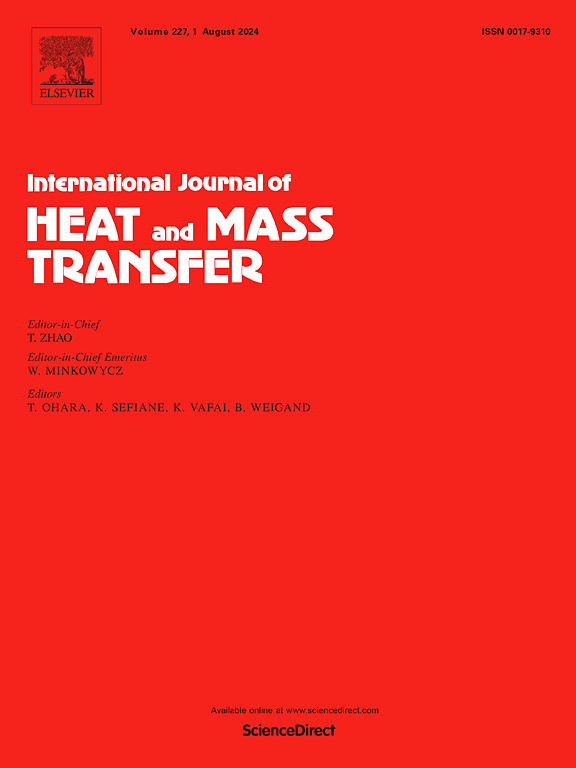分子在稳态净冷凝表面上的输运
IF 5.8
2区 工程技术
Q1 ENGINEERING, MECHANICAL
International Journal of Heat and Mass Transfer
Pub Date : 2025-08-06
DOI:10.1016/j.ijheatmasstransfer.2025.127558
引用次数: 0
摘要
本文研究了非平衡热力学条件下稳态平面冷凝界面的质量和热传递。利用非平衡分子动力学模拟研究了一种相变驱动的纳米泵,该泵由放置在平行铂板之间的液态氩组成。当系统达到统计稳定输运时,这种设置允许对稳态蒸发和冷凝现象进行连续检查。我们研究了在不同热通量下有限界面区域内的温度分布和相关的温度跳变。我们探索了这些温度跳跃与原子穿过界面的能量学之间的关系。Hertz-Knudsen,Schrage模型被许多人广泛用于计算界面质量输运,它使用质量调节系数(s)来计算质量通量。本研究利用拉格朗日框架将总质量通量分解为其组成的蒸发和冷凝分量。该研究进一步利用模型和拉格朗日框架下的测量概率值计算蒸发和凝结系数,并对两种方法进行了比较分析。本研究使用拉格朗日框架对液-气界面的净冷凝进行了全面分析,挑战了经典动力学模型的适用性。值得注意的是,Schrage模型与拉格朗日框架表现出强烈的一致性,加强了其在模拟界面质量输运中的相关性。本文章由计算机程序翻译,如有差异,请以英文原文为准。

Molecular transport across a steady-state net condensing surface
This study investigates interfacial mass and thermal transport across a steady-state flat condensing interface under non-equilibrium thermodynamic conditions. A phase-change driven nanopump, comprising liquid argon placed between parallel platinum plates, has been studied using non-equilibrium molecular dynamics simulations. This setup allows for a continuous examination of steady-state evaporation and condensation phenomena as the system achieves a statistically steady transport. We examined temperature profiles and the associated temperature jumps that occur within the finite interfacial region under various heat fluxes. We explored the correlation between these temperature jumps and the energetics of atoms crossing the interface. Hertz-Knudsen & Schrage models, widely used by many to calculate interfacial mass transport, use the mass accommodation coefficient(s) to compute mass flux. This research utilizes a Lagrangian framework to decompose the total mass flux into its constituent evaporation and condensation components. The study further calculates the evaporation and condensation coefficients using both the models and measured probabilistic values from the Lagrangian framework, providing a comparative analysis of the two approaches. This study presents a comprehensive analysis of net condensation at the liquid-vapor interface using a Lagrangian framework, challenging the applicability of classical kinetic theory models. Notably, the Schrage model exhibits a strong agreement with the Lagrangian framework, reinforcing its relevance in modeling interfacial mass transport.
求助全文
通过发布文献求助,成功后即可免费获取论文全文。
去求助
来源期刊
CiteScore
10.30
自引率
13.50%
发文量
1319
审稿时长
41 days
期刊介绍:
International Journal of Heat and Mass Transfer is the vehicle for the exchange of basic ideas in heat and mass transfer between research workers and engineers throughout the world. It focuses on both analytical and experimental research, with an emphasis on contributions which increase the basic understanding of transfer processes and their application to engineering problems.
Topics include:
-New methods of measuring and/or correlating transport-property data
-Energy engineering
-Environmental applications of heat and/or mass transfer

 求助内容:
求助内容: 应助结果提醒方式:
应助结果提醒方式:


